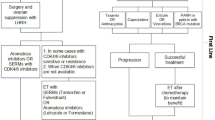Abstract
Intra-tumor heterogeneity, variation between individual tumor cells within a patient’s tumor, is increasingly seen as a critical mechanism underlying treatment resistance and therapeutic failure. Despite this growing awareness, few methods to assess intra-tumor heterogeneity exist outside the research laboratory, especially in the absence of a known marker. Mutant allele tumor heterogeneity (MATH) is a novel, non-biased, quantitative method to assess genetic heterogeneity based on tumor next generation exome sequencing. The quantitative aspect of MATH has allowed it to be verified as an actionable biomarker in a retrospective HNSCC data set with available exome sequencing and clinical data. In addition, it was also capable of stratifying patient outcome after controlling for other high-risk features such as p53 mutation, HPV status, and advanced tumor stage. Future work will explore the predictive power of MATH in larger data sets such as The Cancer Genome Atlas and examine the underlying cellular mechanisms responsible for intra-tumor heterogeneity.





Similar content being viewed by others
References
Burrell RA, Swanton C. Tumour heterogeneity and the evolution of polyclonal drug resistance. Mol Oncol. 2014;8(6):1095–111.
Bedard PL, et al. Tumour heterogeneity in the clinic. Nature. 2013;501(7467):355–64.
Navin N, et al. Tumour evolution inferred by single-cell sequencing. Nature. 2011;472(7341):90–4.
Park SY, et al. Cellular and genetic diversity in the progression of in situ human breast carcinomas to an invasive phenotype. J Clin Invest. 2010;120(2):636–44.
Russnes HG, et al. Insight into the heterogeneity of breast cancer through next-generation sequencing. J Clin Invest. 2011;121(10):3810–8.
Wolff AC, et al. Recommendations for human epidermal growth factor receptor 2 testing in breast cancer: american Society of Clinical Oncology/College of American Pathologists clinical practice guideline update. Arch Pathol Lab Med. 2014;138(2):241–56.
Allison KH, Dintzis SM, Schmidt RA. Frequency of HER2 heterogeneity by fluorescence in situ hybridization according to CAP expert panel recommendations: time for a new look at how to report heterogeneity. Am J Clin Pathol. 2011;136(6):864–71.
Shah SP, et al. Mutational evolution in a lobular breast tumour profiled at single nucleotide resolution. Nature. 2009;461(7265):809–13.
Shah SP, et al. The clonal and mutational evolution spectrum of primary triple-negative breast cancers. Nature. 2012;486(7403):395–9.
Xu X, et al. Single-cell exome sequencing reveals single-nucleotide mutation characteristics of a kidney tumor. Cell. 2012;148(5):886–95.
Crockford A, et al. Implications of intratumour heterogeneity for treatment stratification. J Pathol. 2014;232(2):264–73.
Lim JS, Lee SC. Understanding intra-tumour heterogeneity—the next holy grail of cancer therapeutics? Ann Acad Med Singap. 2014;43(2):72–3.
Stransky N, et al. The mutational landscape of head and neck squamous cell carcinoma. Science. 2011;333(6046):1157–60.
Mroz EA, Rocco JW. MATH, a novel measure of intratumor genetic heterogeneity, is high in poor-outcome classes of head and neck squamous cell carcinoma. Oral Oncol. 2013;49(3):211–5.
Mroz EA, et al. High intratumor genetic heterogeneity is related to worse outcome in patients with head and neck squamous cell carcinoma. Cancer. 2013;119(16):3034–42.
Bonilla-Velez J, et al. Impact of human papillomavirus on oropharyngeal cancer biology and response to therapy: implications for treatment. Otolaryngol Clin North Am. 2013;46(4):521–43.
Renovanz M, Kim EL. Intratumoral heterogeneity, its contribution to therapy resistance and methodological caveats to assessment. Front Oncol. 2014;4:142.
Shackleton M, et al. Heterogeneity in cancer: cancer stem cells versus clonal evolution. Cell. 2009;138(5):822–9.
Polyak K. Tumor heterogeneity confounds and illuminates: a case for Darwinian tumor evolution. Nat Med. 2014;20(4):344–6.
Andre N, Carre M, Pasquier E. Metronomics: towards personalized chemotherapy? Nat Rev Clin Oncol. 2014;11(7):413–31.
Gatenby RA, et al. Adaptive therapy. Cancer Res. 2009;69(11):4894–903.
Gerlinger M, et al. Intratumor heterogeneity and branched evolution revealed by multiregion sequencing. N Engl J Med. 2012;366(10):883–92.
Marabelle A, et al. Intratumoral immunization: a new paradigm for cancer therapy. Clin Cancer Res. 2014;20(7):1747–56.
Al-Lazikani B, Banerji U, Workman P. Combinatorial drug therapy for cancer in the post-genomic era. Nat Biotechnol. 2012;30(7):679–92.
Acknowledgments
I wish to thank Dr. Ed Mroz for helpful comments and suggestions on an earlier draft of this review.
Author information
Authors and Affiliations
Corresponding author
Rights and permissions
About this article
Cite this article
Rocco, J.W. Mutant Allele Tumor Heterogeneity (MATH) and Head and Neck Squamous Cell Carcinoma. Head and Neck Pathol 9, 1–5 (2015). https://doi.org/10.1007/s12105-015-0617-1
Received:
Accepted:
Published:
Issue Date:
DOI: https://doi.org/10.1007/s12105-015-0617-1




